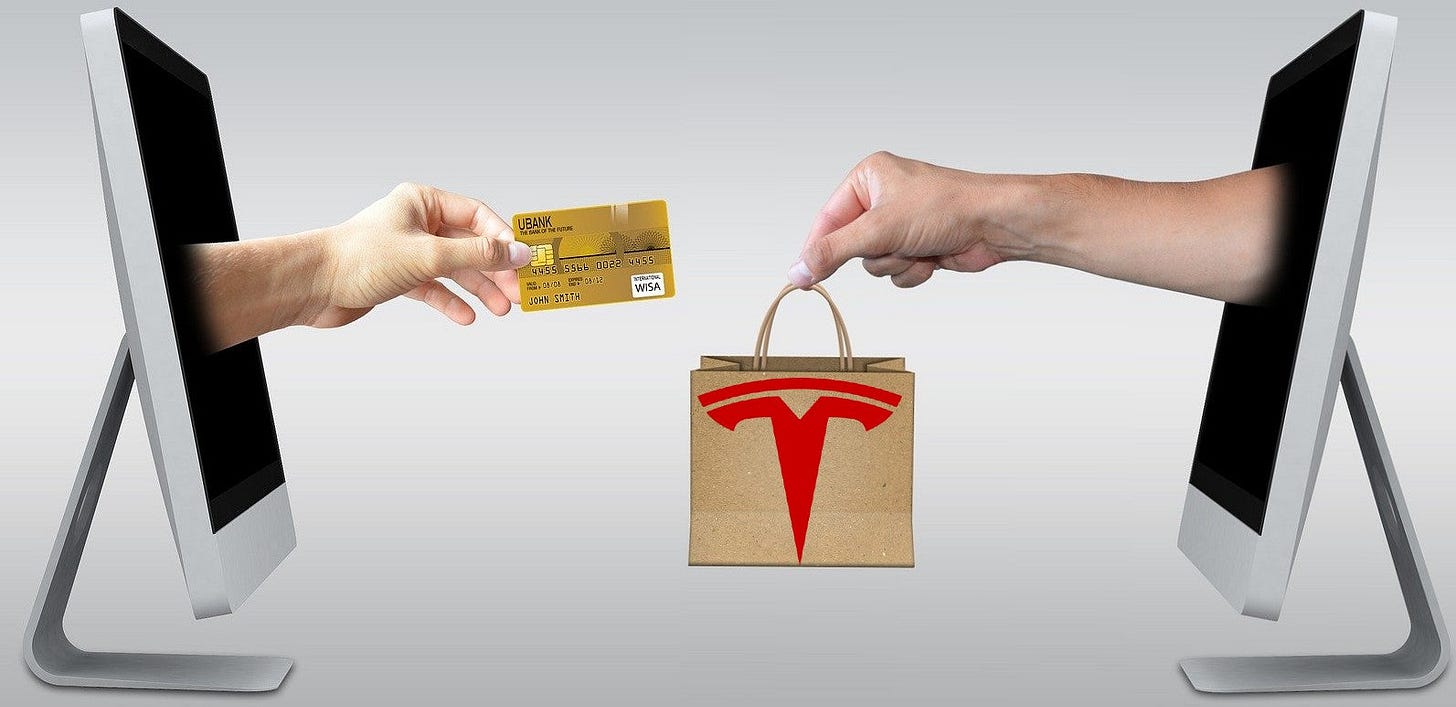#2: Tesla's Direct Sales Model vs. Traditional Car Dealerships
Exploring the Implications of Cutting Out the Middleman in the Automotive Industry
The automotive industry has long been dominated by a traditional sales model involving franchised dealerships. However, Tesla, the pioneering electric vehicle manufacturer, has been shaking things up with its direct-to-consumer approach.
In this post (the idea for which came from a comment on my previous post), we examine the traditional car dealership model, its challenges, and how Tesla's strategy differs.
Understanding the Traditional Car Dealership Model
To grasp the significance of Tesla's direct sales approach, it is essential to understand how the traditional car dealership model works:
Manufacturers (like Ford, Hyundai, and Toyota) produce vehicles and sell them to independent dealerships at wholesale prices.
Dealerships then sell the cars to consumers at a markup, which is how they generate profits.
Dealerships are typically franchises, meaning they have contracts with manufacturers that grant them the right to sell vehicles within a specific geographic area.
These franchises are responsible for displaying vehicles, arranging test drives, negotiating prices, and handling paperwork.
Dealerships also offer financing options, vehicle maintenance, and repair services, and sell auto parts and accessories.
Unsold inventory is a significant challenge for dealerships. They often resort to incentives, discounts, trade-ins, and even selling vehicles at a loss to clear out older models.
This model, which dates back to the early 20th century, was initially designed to help car manufacturers quickly sell vehicles to generate cash flow.
However, as the "Big Three" automakers (General Motors, Ford, and Chrysler) gained market power in the 1930s and '40s, they began pressuring dealerships.
In response, U.S. dealerships successfully lobbied for state laws protecting their interests, known as "franchise laws," which require car manufacturers to sell through independent dealerships.
The Pitfalls of the Traditional Model
The traditional car dealership model has several drawbacks for various stakeholders:
Consumers often face high-pressure sales tactics, confusing pricing, and a lack of transparency.
Dealerships have to balance the demands of both manufacturers and consumers, leading to potential conflicts of interest.
Automakers have less control over the customer experience and may struggle to introduce new technologies or sales strategies.
How Tesla is Changing the Game
Tesla sells its electric vehicles directly to consumers through company-owned showrooms and online.
This model offers several advantages:
Control over brand experience: By owning the entire sales process, Tesla can ensure a consistent, high-quality customer experience across all touchpoints. This allows the company to better educate consumers about electric vehicles and maintain a strong brand identity.
Transparent pricing: Tesla offers fixed, transparent pricing without the need for haggling or hidden fees. This simplifies the buying process and builds trust with consumers who appreciate the straightforward approach.
Streamlined process: By cutting out the middleman, Tesla can simplify the car buying process for consumers. This includes a more seamless integration of online and in-person sales, as well as a more efficient delivery process.
Direct relationship with customers: Tesla can gather valuable data and feedback directly from its customers to inform future product development. This direct relationship also allows for more effective communication regarding software updates, recalls, and other important information.
You can read about why Tesla chose this model in the blog post here written by Elon Musk himself.
Tesla's Potential Impact on the Indian Market
As Tesla gears up to enter the Indian market, its direct sales model could have a significant impact on the country's automotive industry. India's car dealership landscape is similar to that of the U.S., with manufacturers selling through franchised dealerships. However, the market is highly fragmented, with many small, independent dealerships operating alongside larger, well-established players.
Tesla's entry could disrupt this status quo by offering a more streamlined, transparent buying experience. Additionally, the company's focus on electric vehicles aligns with India's push towards sustainable transportation. However, Tesla will likely face challenges in navigating India's complex regulatory environment and establishing the necessary infrastructure for its direct sales model.
Choosing the Right Model for the Right Company
The suitability of the direct sales model versus the traditional dealership model depends on various factors, such as the type of vehicles being sold, the target market, and the company's overall strategy.
The direct sales model may be more appropriate for:
Companies selling innovative, high-tech vehicles that require extensive customer education (e.g., electric vehicles)
Luxury or niche brands that prioritize customer experience and brand control
Startups or smaller manufacturers that want to minimize costs and maintain direct customer relationships
The traditional dealership model may be better suited for:
Mass-market brands with a wide range of models and price points
Companies with an established presence and strong relationships with dealerships
Manufacturers that want to outsource sales and services to focus on production
As the automotive landscape continues to evolve, companies must carefully consider which sales model aligns best with their products, target market, and overall strategy. The battle between direct sales and the traditional dealership model is far from over, and its outcome will have significant implications for the future of the automotive industry, both in the U.S. and in emerging markets like India.
Until next time!
Do you think direct sales will eventually become the norm, or will dealerships adapt and maintain their dominance? Share your vision and ideas in the comments below.







